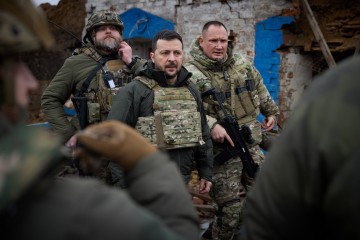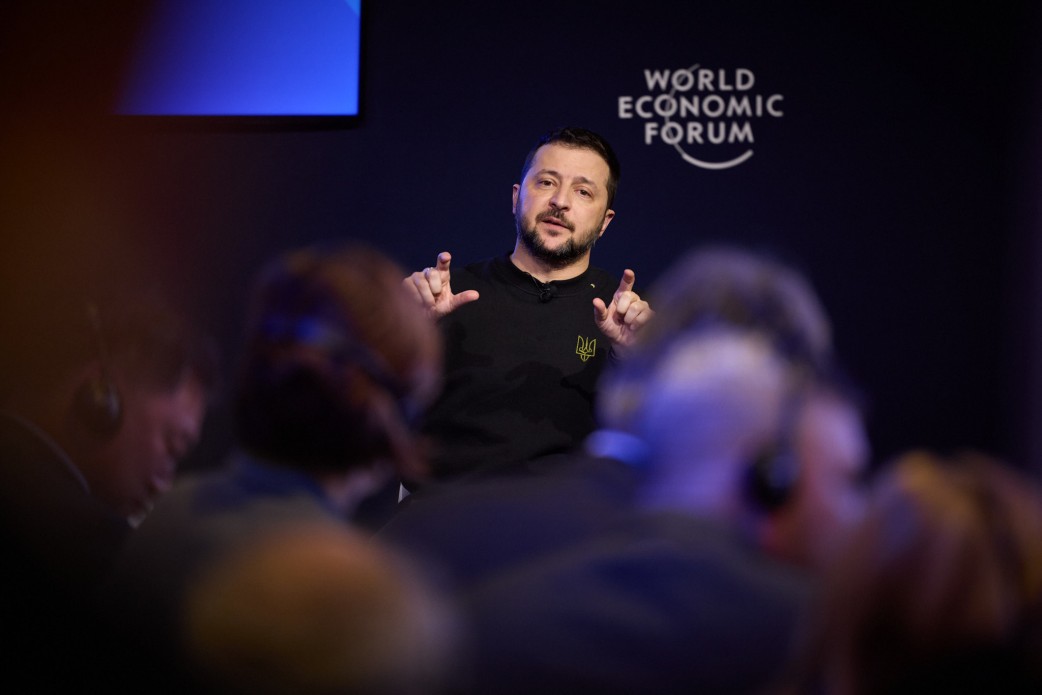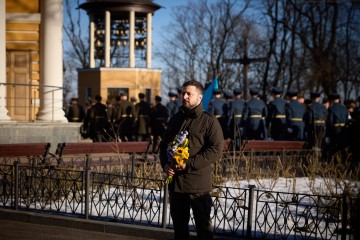
(Ukrainian President Zelensky visting troops at the front)
As the war grinds on in Ukraine, Speaker of the House Mike Johnson remains adamant that he will not bring to the House floor for a vote a bi-partisan bill negotiated by Democratic and Republican senators that would provide aid to Ukraine, Israel, Taiwan, and funds to deal with the crisis at our southern border. It seems that Donald Trump has instructed the Speaker on how to proceed with the legislation because if it passed it would provide President Biden a political victory during our election season. The fact that Ukraine is slowly running out of munitions and weapons has no impact on the MAGA world as its goal is to re-elect former President Trump and the consequences be damned. Vladimir Putin sits in the Kremlin with that cheshire smile on his face laughing on the inside as he observes the political chaos in Congress and believes that anything that would return Trump to the White House would benefit Russia. The result is that he will drag the war of attrition out further in the hope of achieving that goal.
Meanwhile, frustration in Kyiv, NATO headquarters, European capitals, and Washington is reaching new heights as the Biden administration tries to cull a deal. The man responsible for leading the Ukrainian people, President Volodymyr Zelensky tries his best to convince House and Senate members of the crisis that will ensue in Europe and the threats it will create should Russia prevail. Zelensky is the key figure in the process and is the subject of Time magazine correspondent Simon Shuster’s new book THE SHOWMAN: THE INSIDE STORY OF THE INVASION THAT SHOOK THE WORLD AND MADE A LEADER OUT OF VOLODYMYR ZELENSKY which provides in intimate detail the story of Zelensky’s evolution from a professional comedian to a symbol of Ukrainian resistance to the Russian invasion of February 24, 2022 and how he has tried to rally western democracies to support his cause and bring about Russia’s defeat in Crimea and eastern Ukraine.

There are a number of important books concerning Russia’s invasion of Ukraine and Ukrainian history. Most recent are those by Yaroslav Hrytsak, Serhii Plokhy, Owen Matthews, Joshua Yaffa, Paul D’Anieri, Christopher M. Smith, Jade McGlynn, Luke Harding, and Christopher Miller. All are excellent monographs, but Shuster’s biography brings the life and actions of President Zelensky into greater focus than other authors.
Shuster offers an unparalleled look at what Zelensky, his wife Olena Zelenskaya, his two children, and the Ukrainian people experienced as the war drew closer, and the actual invasion and its consequences. Shuster zeroes in on Zelinsky’s decision making, tactics to try and invigorate and reassure the Ukrainian people, and the impact of the strategic approach taken by the Ukrainian military leadership. All aspects of the war are explored with many insights and airtight analysis.
Shuster does well in describing Zelensky’s rise from being an entertainer to a successful politician. Among the important points he makes focuses on the characteristics and talents of the comedic world and the entertainment business that Zelinsky developed over the years and how he employed them in his transition to politics. Many of the individuals who worked with him in his production company would find themselves as part of his “inner governing circle” once he assumed the presidency of Ukraine.

(The liberation of Kherson from Russian troops)
There are a number of interesting points that Shuster offers in dealing with Zelensky’s approach to Putin, the preparation of the domestic population for war, and the outbreak of war itself. For a long time Zelensky was under the delusion that he could deal with Putin on a one to one basis. He believed once he sat down with him he could rely on his personal persuasive talents to come to agreements with the former KGB operative. This reflects Zelensky’s naivete when it came to Putin. I am certain that Zelinsky was completely aware of Putin’s Pan Slavic beliefs, his mantra that Ukraine was part of Russia, not a separate country, and a modus operandi employing “little green men” in eastern Ukraine, Crimea. Zelensky did get his face to face with Putin and negotiations in 2019 which in the end were a failure. Prisoner swaps were agreed to but on issues of substance dating back to the Orange Revolution of 2014 there was no progress. Putin was inflexible, arguing there were no Russian troops in the Donbas region so Zelinsky’s goal of Russian troop withdrawal before any elections could take place was a non-starter.
Zelensky firmly believed that war could be avoided and did his best to prevent a furtherance of a conflict that began in 2014. He refused to accept American intelligence that the war was imminent. He was overly careful in making war preparations fearing he would scare the Ukrainian people, would harm the domestic economy as Ukraine was dependent upon Russia for gas and oil and a significant amount of investment would be lost, and lastly, it would send the wrong message to Putin fostering an invasion. Nationalists in the Ukrainian parliament opposed Zelensky’s stance arguing he was selling out to the Russians.

(Ukraine’s First Lady Olena Zelenskaya)
Shuster is correct in that Putin was a spy who believed in subterfuge as opposed to direct combat. A prime example is Putin’s relationship with Viktor Medvedchuk, a Ukrainian media billionaire who was Zelensky’s main political opponent. Medvedchuk’s relationship went back decades with Putin attending his wedding and was the godfather to his daughter. In reality Medvedchuk, a member of parliament, was Putin’s surrogate whose media empire attacked Zelensky repeatedly, particularly over his Covid vaccine policies as Putin’s “Trojan Horse.” As Zelensky’s popularity declined in 2019 and 2020 and Medvedchuk’s political party made gains in parliament, Putin came to believe that he could achieve his takeover of Ukraine by democratic means once his surrogate replaced Zelensky. This was not to be as Zelensky confiscated Medvedchuk’s assets which Shuster argues pushed Putin toward invasion and restore what he termed the “historical unity” between Russia and Ukraine.
Many wonder why Ukraine was able to push back the invasion within a few weeks. The key was the battle for Kyiv which was the most significant combat in Europe since World War II. Others have reflected on the idea that Russia relied on maps that dated to 1989, the fact that troops and certain commanders did not receive their orders until two days before the invasion, the Russian military did not train enough for the type of resistance it came upon, etc. But the keys as Shuster points out were the purchase of Bayraktars drones from Turkey which were successful against the long Russian columns of tanks, artillery, and other equipment and supplies. The appointment of Major-General Valery Zaluzhny as commander of Ukrainian forces as unlike senior Ukrainian officers he was not trained in the Soviet model of warfare, and he implemented a more offensive approach toward the Russians in the east. Now they could fire back, something they had been restrained from doing before Zaluzhny took command. Lastly, American satellite intelligence proved a boon to Ukrainian defense and offensive actions.

(Results of Russian atrocities in Bucha)
Shuster describes the atrocities of Bucha in intimate detail, the key battle for Mariupol, the siege at the Azovstal Steel works and the fighting in Kyiv suburbs. He describes a leader who seemed to find himself and employ his communication talents once the invasion began. He kept pushing for American and European weaponry which in large part was successful as the war ground on. One of the key elements for war on Putin’s part was the weakening of NATO and blocking Ukrainian membership in the alliance. Putin’s goals backfired as Ukrainian military needs were met by the west. Kyiv gave up old Soviet military weapons and systems and integrated NATO equipment into its military arsenal. The more weapons that arrived and with the training of Ukrainian forces by NATO, more and more they became a western force. Further, to Putin’s anger, Finland and Sweden joined NATO increasing NATO’s presence on its 900 mile border with Finland. Putin’s response was vindictive bombing of civilians and threats of nuclear war.
(Ukrainian President Volodymyr Zelensky (L) and Russian President Vladimir Putin (R) arrive to attend a meeting on Ukraine with French President and German Chancelor at the Elysee Palace, on December 9, 2019 in Paris. – Russian president will for the first time hold formal talks with his Ukrainian counterpart over the conflict in Ukraine’s east, at a much-anticipated summit in Paris)

(Ukrainian President Volodymyr Zelensky (L) and Russian President Vladimir Putin (R) arrive to attend a meeting on Ukraine with French President and German Chancelor at the Elysee Palace, on December 9, 2019 in Paris. – Russian president will for the first time hold formal talks with his Ukrainian counterpart over the conflict in Ukraine’s east, at a much-anticipated summit in Paris)
Shuster has not produced a work of hagiography as is seen by his commentary on prewar policies and digs around the corrupt oligarchs in Zelensky’s orbit. Despite this THE SHOWMAN is a portrait of a brave, inspirational, and bold leader who did not shy away from danger, visiting troops and combat areas to share in some way what his people were experiencing. Shuster, who has been reporting from Kyiv since 2009, relies a great deal on interviews with the most important players in the Ukrainian drama. He would interview Zelensky in 2019 as a presidential candidate and was able to become part of his inner circle and shadow him for the first year of the war. He points to Zelensky’s limited experience as a statesman who was able to gain the trust and support from the West employing “incessant repetition” of his demands through rhetoric, his personality, and commitment to his cause. Zelensky did resort to highhandedness at times which Shuster blames on the exigency of war, not any drive toward autocracy.
Zelensky’s transformation into a wartime leader was not predictable and he evolved turning the conflict into one the West would take ownership of. The problem is that as the war continues it seems the West might be losing interest, or “Ukraine fatigue,” as the Republican Congress threatens further military aid, and Donald Trump may appear on the horizon as President which would play into Putin’s hands. This fear was reaffirmed this weakened at a Trump political rally as the ex-president pontificated on NATO warning members that if they didn’t pay enough dues he would not honor Article Five of the NATO charter. He further stated that if that were the case he would encourage Putin to do “as he damned well pleased” and even encouraged the Russian autocrat to invade westward. In the interim the conflict is pretty much frozen on the battlefield as both sides fight for limited territory. The problem is should Ukraine run out of certain weapons by spring it could lead to negotiations where Putin achieves most of his demands or obtains out and out military victory and the end of a free Ukraine.

